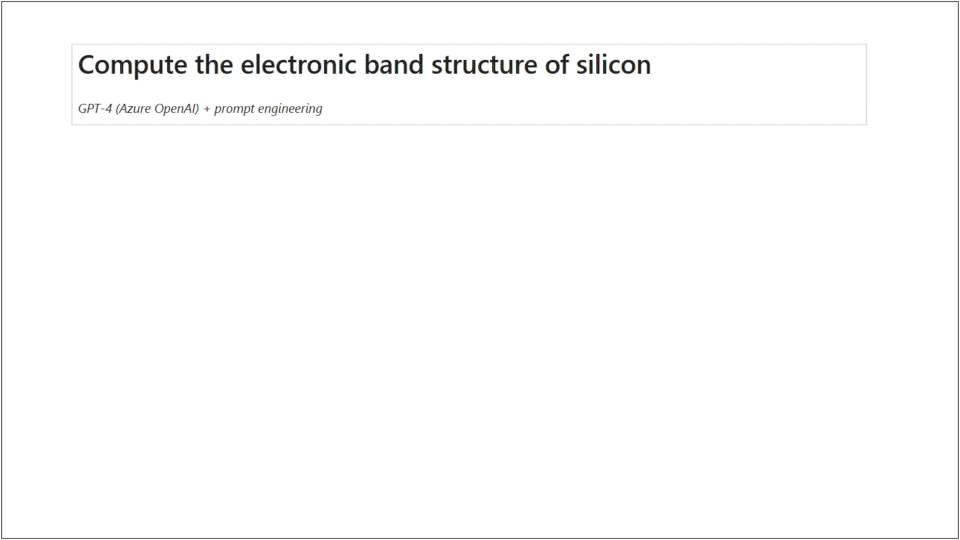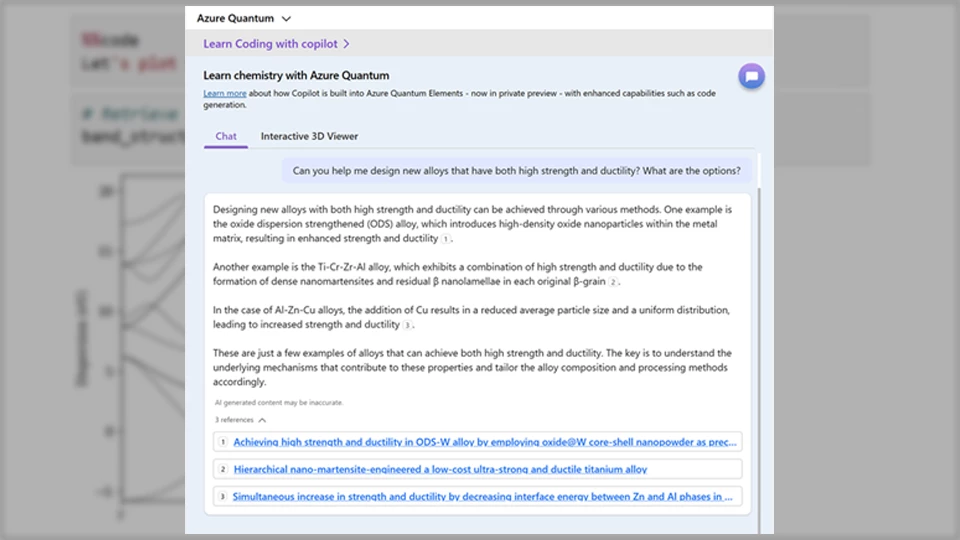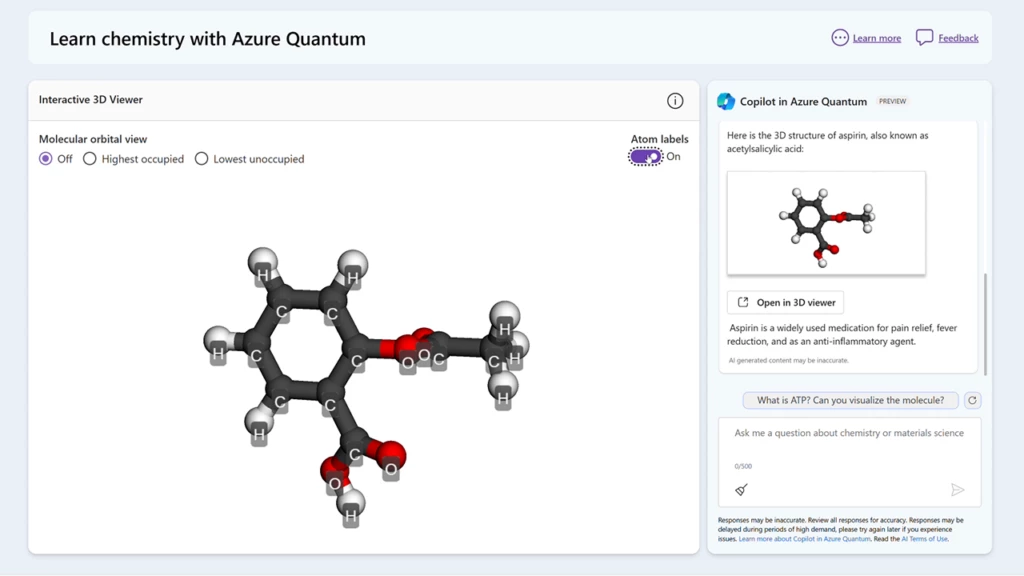At Microsoft, we see opportunities to accelerate research and development (R&D) productivity and usher in a new era of scientific discovery by harnessing the power of today’s new generation of AI. In pursuit of this goal, we recently released Copilot in Azure Quantum Elements, which enables scientists to use natural language to reason through, and orchestrate solutions to, some of the most complex chemistry and materials science problems—from developing safer and more sustainable products to accelerating drug discovery. With Copilot, researchers no longer need to manually sift through countless research papers in search of relevant data. Furthermore, scientists can turn a few words of natural language into chemistry simulation code, and students can use interactive exercises to learn quantum computing concepts.

Helping researchers learn and do more with Copilot
We are living through a time of rapid technological change, which will transform nearly every aspect of work and life. As one potent example, today’s new generation of AI and large language models are allowing us to tap into our universal user interface—natural language—to make tasks more efficient.
In a recent post, we highlighted how we combined property-prediction AI models for new materials with HPC calculations to digitally screen candidates. This work highlighted the acceleration capabilities that AI provides in a digital discovery pipeline. With the addition of large language models, AI can provide even more opportunities to increase research productivity.
The launch of Copilot—providing free capabilities online and deeper integration within Azure Quantum Elements—was driven by the desire to increase research productivity and prioritize the needs of innovators, equipping them with a seamless user experience that can make complex simulations more manageable. Copilot in Azure Quantum is built on Azure OpenAI services and grounded on chemistry and materials science data from over 300,000 open-source documents, publications, textbooks, and manuals. This means users can get technical and guided answers, query and visualize data, and initiate simulations—in turn reducing the barriers to configuring and launching workflows. Furthermore, Copilot can help innovators prepare for a quantum future with interactive exercises for learning about quantum computing and writing code for today’s quantum computers.
Lowering the entry barrier for chemistry simulations: code generation for scientific workflows
Computational workflows can be complex, and usually require a deep understanding of a variety of software packages and codes. With Copilot integrated into Azure Quantum Elements, scientists can now run simulations without having to write all of the code themselves, due to Copilot’s ability to generate code for both new and existing workflows within a Jupyter notebook.
For instance, Copilot can generate code to help model the electronic structure of a molecule with density functional theory (DFT) calculations. DFT is one of the most popular computational chemistry methods due to its efficiency and accuracy on a wide range of quantum mechanical properties, aiding with electronic structure visualization and many other property evaluation applications.
Furthermore, Copilot can describe the computational approach for addressing a scientific problem and instruct the system to configure both the underlying software needed and the hardware on which to run it. This greatly lowers the barriers to running chemistry and materials science workflows. The example below highlights Copilot’s ability to use the Quantum ESPRESSO package and write code for calculating the band structure of indium arsenide, a semiconductor, using the AiiDA workflow manager.

Tuned for scientific research: Retrieval Augmented Generation capabilities
While Copilot’s integrated coding features are currently only available for Azure Quantum Elements customers, Copilot also offers free capabilities to help streamline research. Using these features, scientists can save valuable time by using Copilot to find and summarize relevant studies and articles quickly. This is possible because Copilot can reference publicly available scientific research papers that are acceptable for commercial use.
This referencing capability is possible via grounding, a technique in which AI models extract relevant information from various data sets, enabling them to generate correct answers to questions. Grounding is based on Retrieval Augmented Generation (RAG), which helps large language models extract insights from large amounts of supplemental and business-specific data without having to retrain the models on new information—a very expensive task. With RAG, the large language model searches a supplemental dataset and matches the user’s prompt to the relevant chunks within, which are then summarized. You can learn more about grounding data in a recent Microsoft Research article.
With these capabilities in Copilot, researchers can obtain technical answers to a wide variety of scientific questions. As an example, the following illustration shows Copilot citing recent research articles to answer the question, “Can you help me design new alloys that have both high strength and ductility? What are the options?”

Grounded with additional chemistry and materials science data: molecular visualization and proprietary datasets
In addition to being grounded on publicly available research papers for text queries, Copilot in Azure Quantum is also augmented with molecular structure data. This means that researchers can visualize molecules, derived from millions of possibilities, as well as calculate their respective orbitals1. As an example, Copilot can visualize the molecule found in aspirin, acetylsalicylic acid. Regardless of whether the text input was aspirin or acetylsalicylic acid, Copilot would display the same molecule.

Copilot’s molecular visualization capabilities are available for free. Furthermore, our Azure Quantum team is hard at work to pioneer new Copilot capabilities—for future integration within Azure Quantum Elements—that would enable enterprise customers to create a customized Copilot experience grounded on their own proprietary data. More information about the private preview of Azure Quantum Elements is available here.
Learning about quantum computing with the Azure Quantum Katas
Copilot is fueling scientific discovery and also nurturing a robust ecosystem of quantum innovators. To help prepare for a quantum future, we recently released the Azure Quantum Katas, which are free, self-paced, Copilot-assisted programming exercises that teach the elements of quantum computing and the Q# programming language. Learners can start exploring the hands-on exercises with no installation or subscription required.
Learn more about Azure Quantum Elements
Interested to learn more about how the power of the Azure cloud can help you? Here are additional resources:
- Try Copilot for chemistry and Azure Quantum Q# coding.
- Sign up to learn more about the private preview of Azure Quantum Elements.
- Read our recent paper in collaboration with AI4Science—The Impact of Large Language Models on Scientific Discovery: a preliminary Study using GPT-4.
- Visit the Azure Quantum Elements website and check out the Microsoft Quantum Innovator Series webinars.
1Calculations performed using xTB container running in Azure K8S.
